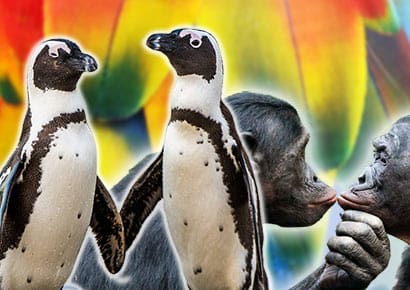Do it like they do on the Discovery Channel: homosexuality in nature
 The argument that homosexual behaviour is an unnatural sex act is a denouncement that is popular among many opponents of same-sex marriage and LGBTQ rights. So how common is homosexuality in nature?
The argument that homosexual behaviour is an unnatural sex act is a denouncement that is popular among many opponents of same-sex marriage and LGBTQ rights. So how common is homosexuality in nature?
The belief that same-sex sexual interactions are a human ‘perversion’ has its roots primarily in religious and natural theory, with the medieval theologian and philosopher Thomas Aquinas calling homosexual acts “peccatum contra naturam” or “sins against nature” and the natural order of the world.
Ironically, Aquinas was also a strong proponent of the value of reason, which he equated as a part of secular natural law (not to be confused with religious eternal law). Had he been alive today and gathered modern knowledge about homosexual behaviour in the natural world, he might have thought otherwise.
You and me, baby, ain’t nothing but mammals
Homosexual behaviour has been noted among many species – not just mammals. Bruce Bagemihl’s groundbreaking book, Biological Exuberance: Animal Homosexuality and Natural Diversity, first brought together findings about homosexual and bisexual behaviour patterns in 1999. This behaviour has been observed across over 450 species, including animals from a range of groups, including reptiles, insects and primates.
Seen from an evolutionary perspective, homosexual behaviour in the natural world should seemingly not exist, seeing as it does not result in reproduction, and does not meet the fundamental criterion for the passing on of genes. Even so, homosexual behaviour in nature does exist, and scientists have speculated that there might be a number of reasons for this.
Some animals, like American bison and young rams use homosexual intercourse as a type of practice for engaging in heterosexual behaviour. Others, like bonobos, use homosexual activity to forge social bonds and alliances, as well as to reduce conflict and form pairs so they can defend themselves against larger bonobos when intrasexual competition for females is high.
Among animals that form monogamous pair-bonds, like certain types of seagulls, dolphins and penguins, same sex pair bonding might occur to ensure that the offspring resulting from extra-pair copulations are still cared for by two parents.
Whatever the reason for homosexual behaviour in nature, one cannot get away from the fact that it does happen, and that there is much larger sexual fluidity in the animal kingdom than medieval philosophers could ever have contemplated.
Homophobia is unnatural
An exhibition which ran at the Oslo Natural History Museum in Norway from September 2006 to August 2007 (aptly titled “Against Nature?”) focused on the occurrence and function of homosexuality in nature.
In 2007, the scientific advisor of the exhibition, Petter Bockman theorised that the extent of homosexual behaviour in animals may be larger than they thought at the time, saying, “No species has been found in which homosexual behaviour has not been shown to exist, with the exception of species that never have sex at all, such as sea urchins and aphis. Moreover, a part of the animal kingdom is hermaphroditic, truly bisexual. For them, homosexuality is not an issue.”
The central conflict in beliefs around homosexuality seems to be in the way it is perceived by a particular species. Speaking in a video for the Out4Marriage campaign in 2012, the openly gay actor, writer and activist Stephen Fry perhaps put it most eloquently of all, saying, “At least 260 species of animal have been noted exhibiting homosexual behaviour, but only one species of animal ever, so far as we know, has exhibited homophobic behaviour – and that’s the human being. So ask which is really natural.”
There was an opportunity here to provide actual in depth examples instead of rehashing what we all know – that it is a natural occurrence. Maybe provide some real world examples – might make it more relatable to the reader